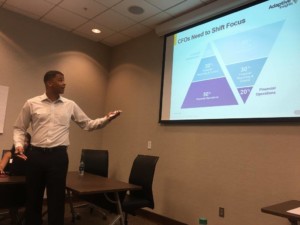How to Lead Your Business with Better FP&A Insights
Last week, InnoVergent, in partnership with Adaptive Insights, hosted a seminar on the future on Financial Planning and Analysis (FP&A). Joseph Denk, InnoVergent’s Financial Consultant, presented five points addressing some of the main issues that CFOs are facing these days.
Some of the major inhibitors to being more strategic included:
- Challenges in the planning process
- Lack of time for reporting and analytics
- Data-driven decision-making is impacted
Additionally, Joseph revealed a series of relevant statistics demonstrating that long planning cycle times, inconsistent processes, data integrity issues and limited business engagement seem to be recurring issues that might be holding companies back.
So, what are the main strategies to help businesses accelerate their FP&A journey?
Drive Enterprise-Wide Collaboration
Budgeting and forecasting need to be integrated and a part of the company’s culture. For this reason, reinforcing a collaborative effort between the executive, finance, sales and marketing and operations teams will be vital.
Enable a Self-Service On-Demand Culture
When re-engineering the process and getting managers more involved, it’s important to keep the work simple. A good way to achieve this is by implementing self-service. Through this, not only can business users be self-sufficient, but they can also get real-time answers and update their plans and forecasts on demand as their needs evolve.
Create Driver-Based Plans & Rolling Forecasts to Drill
Being consistently evolving with your business by creating driver-based plans and rolling forecasts makes it easier to stay ahead of the curve. This will help you enhance competitiveness and the value of your business, as well as increasing the transparency, visibility and integrity of your financial projections.
Automate KPIs, Dashboards, and Scorecards
The old model of separate dashboards, reporting and planning initiatives is no longer enough. Data-driven managers need to not just see performance, but be equipped to make better decisions by promoting a culture of analytics and metrics. The ultimate goal? To create a continuous cycle, all managed by Finance.
Close and Disclose Quickly and Accurately
Automation is the first thing you can do on your path to an efficient close. Even though tools such as Excel might be extremely useful for Finance, processes like journal adjustments, intercompany eliminations and reclassifications are well-suited for automation. Having software to help standardize workflows and allow you to monitor execution of tasks will allow you to identify other areas of improvement.
Want to learn more? Join our next event for Finance executives!


Our next FP&A best practices seminar will be hosted virtually.
Click below to receive updates on our summer webinar series for FP&A professionals.
